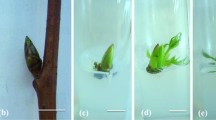Abstract.
Micropropagation of mature Taxus mariei was achieved using bud explants derived from approximately 1,000-year-old field-grown trees. Bud explants derived from 1-year-old stecklings raised from rooted cuttings of these trees were included in this study for comparison. Steckling-derived explants collected in different seasons showed high survival rates and good growth performance in vitro, whereas the survival of mature tree-derived explants was highly season dependent, with satisfactory survival in early spring only. During successive subculturing, tissue browning was observed in cultures of both origins, but the problem was circumvented by supplementing the basal medium with 1 g l–1 activated charcoal and 100 mg l–1 silver nitrate. The steckling-derived cultures performed better than mature tree-derived cultures in terms of shoot multiplication and rooting ability. New shoots of both origins exhibited plagiotropic growth, but steckling-derived shoots had a smaller plagiotropic angle (near vertical) than mature tree-derived shoots. In both cases, the plagiotropic angles decreased after these subcultures were maintained in shoot multiplication conditions for half a year. Orthotropic growth was restored in 25% and 10% of the steckling- and mature tree-derived cultures, respectively.
Similar content being viewed by others
Author information
Authors and Affiliations
Additional information
Electronic Publication
Rights and permissions
About this article
Cite this article
Chang, SH., Ho, CK., Chen, ZZ. et al. Micropropagation of Taxus mairei from mature trees. Plant Cell Rep 20, 496–502 (2001). https://doi.org/10.1007/s002990100362
Received:
Accepted:
Published:
Issue Date:
DOI: https://doi.org/10.1007/s002990100362




